Download PDF
Download page Snowmelt Modeling – Automating the Development of ATI-Meltrate Functions.
Snowmelt Modeling – Automating the Development of ATI-Meltrate Functions
Myles McManus, P.E.
Snowmelt can be a significant source of runoff depending on the geographical, topographical, and seasonal characteristics of a watershed. The Hydrologic Engineering Center's Hydrologic Modeling System (HEC-HMS) software can capture the phase change from ice to liquid water using a temperature index approach. This snowmelt modeling component of HEC-HMS is used in the Corps Water Management System (CWMS) for real time forecasts in watersheds that require snowmelt hydrology for more accurate results. Figure 1 illustrates snowfall amounts over the U.S. for the purpose of illustrating that significant portions of the country have snowmelt runoff.
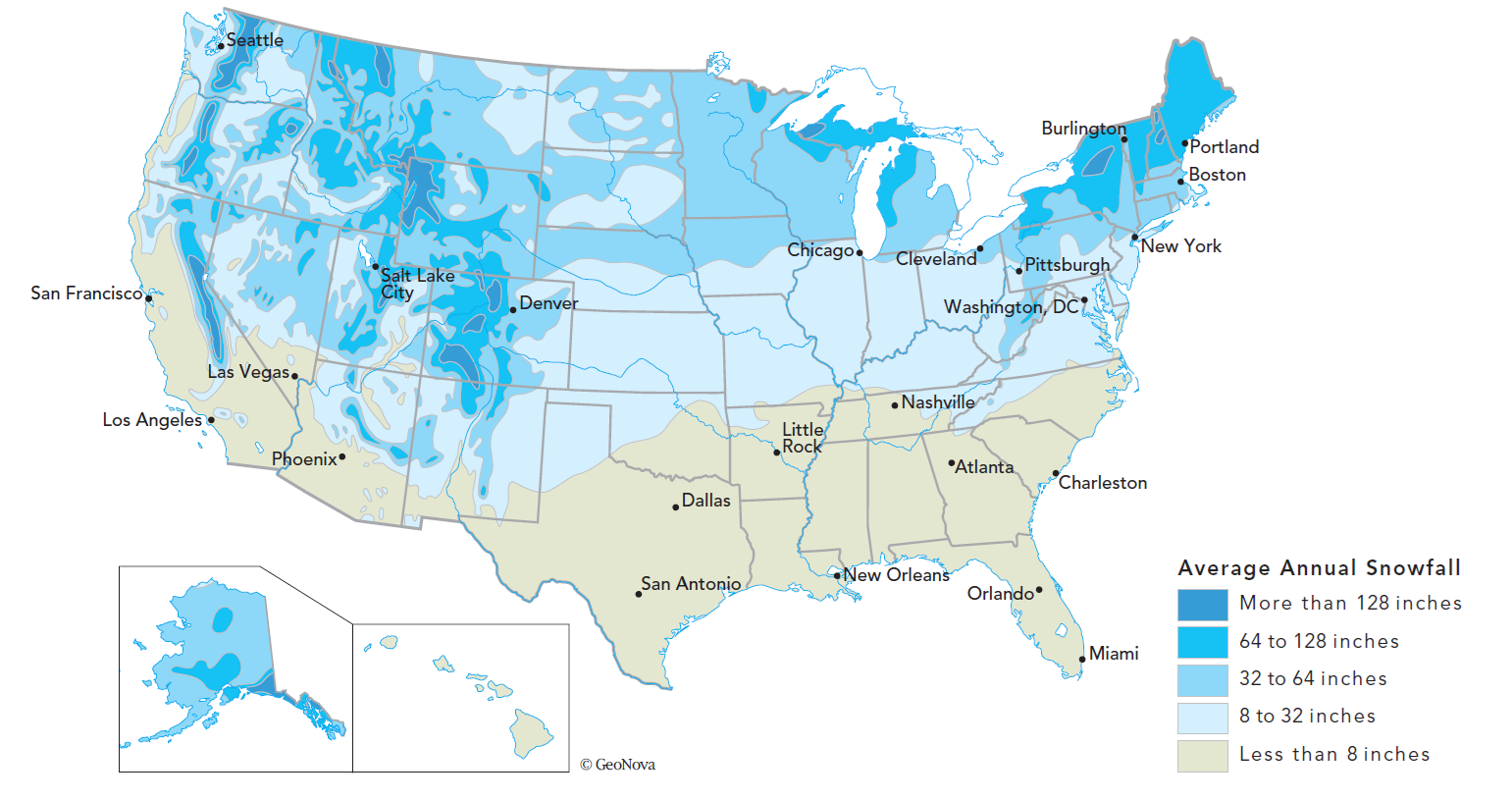
When snow melts, the ice that composes the snow is converted into water. This process is called ablation. The water content of a snowpack is typically expressed as snow water equivalent (SWE), which is the depth of water that results from melting a unit column of the snowpack. Since the conversion from ice to water requires the input of energy (or heat), the process of snowmelt is linked to the flow and storage of energy into and through the snowpack. Estimates of snowmelt amounts are derived using the energy balance equation or by an empirically defined snowmelt index.
HEC-HMS uses the temperature index method to model snow accumulation and ablation. The temperature index snow model requires temperature and precipitation data. In its simplest form, a temperature index model is based on the hypothesis that snowmelt is proportional to the difference between air temperature and a threshold melt temperature. The method has been widely used with good results, but it requires parameter calibration. Figure 2 illustrates all the parameters needed for the gridded temperature index method in HEC-HMS.
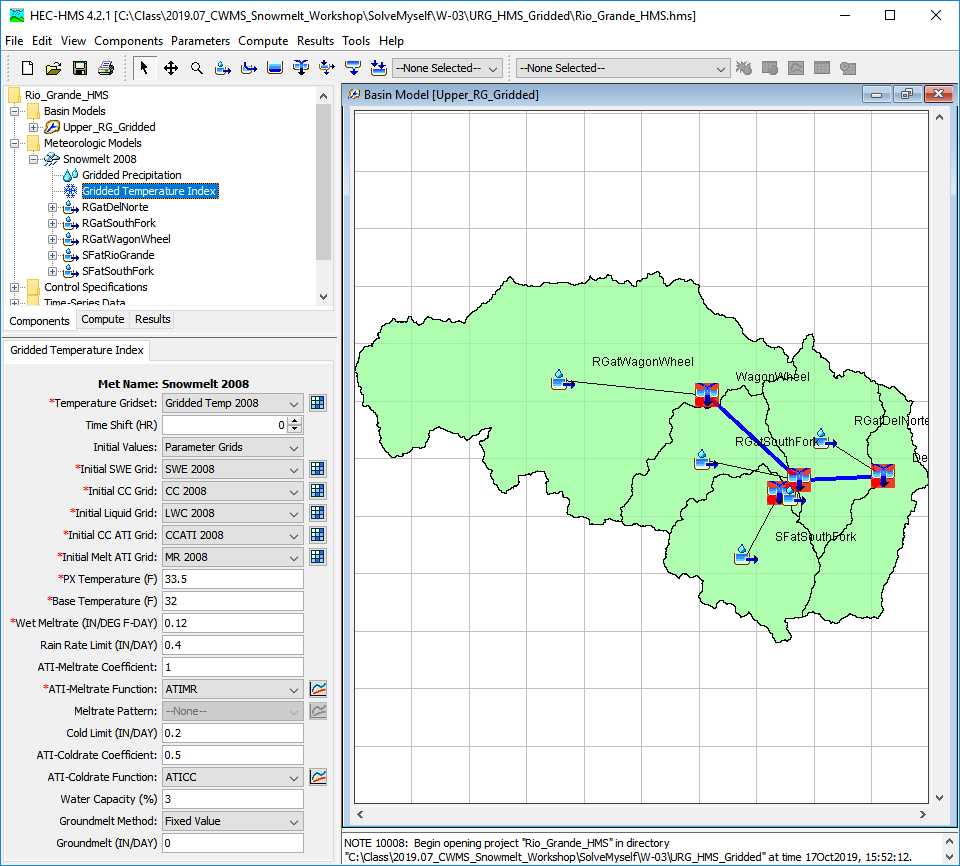
One of the required parameters is the ATI-meltrate function. This function is a paired data table that gives the meltrate for a given Antecedent Temperature Index (ATI). An example ATI-Meltrate table is shown in the Figure 3.
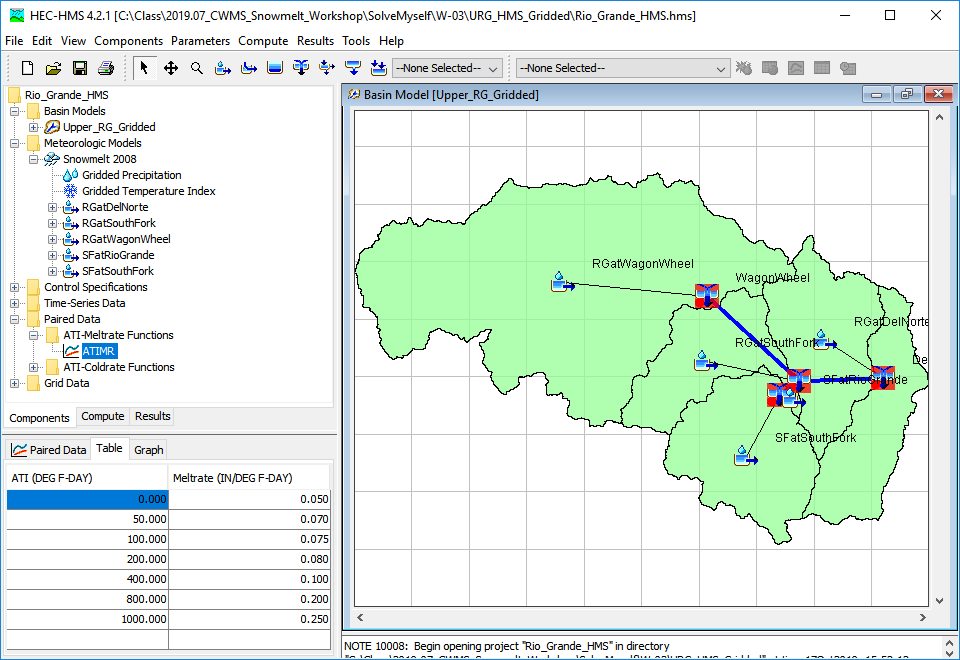
The ATI-Meltrate function is often the snowmelt model parameter with the greatest impact on results. Snowmelt rates are a function of the physical characteristics of a region, including: Forest cover, topography, and average weather conditions. Typically during a simulation when snow is only present for a few days, or the SWE is only a few inches in depth, a constant ATI-Meltrate function should be used where the meltrate does not change with ATI. Otherwise, when snow cover lasts longer than a month, or the max SWE is greater than 10 inches, then a variable ATI-Meltrate function is most appropriate.
The ATI-Melt Rate function relates the sensitivity of the melt rate throughout the season to the accumulated thawing degree days. ATI is calculated in the temperature index model at time step t+1 as:
ATI_{(t-1)}=(ATIMR_{coeff}*ATI_{t })+(T_a-T_{base})*S
where ATIMRcoeff is the ATI-Meltrate Coefficient, Ta is the input air temperature, Tbase is the Base Temperature, and S is the model time step in days. In general, ATI is only advanced when Ta > Tbase.
Typical values used for:
ATI-Meltrate Coefficient = 1.0.
Base Temperature = 32 degrees Fahrenheit.
When developing the ATI-Meltrate Function Table it is important to understand how the basin characteristics affect the melt rates. Observed data within the basin can be used to develop the ATI-Meltrate Function that best fits across multiple sites and years. To develop this table, a couple parameters need to be calculated: ATI and Cumulative Melt. The cumulative melt represents the amount of SWE that has melted into water.
From observed data, the ATI can be calculated at a location using Temperature and SWE data. ATI accumulates over each timestep while there is SWE available at a location. The amount of ATI that accumulates is the difference in the temperature and the base temperature (typically 32 degrees Fahrenheit). For example, the table below illustrates ATI accumulating over time for a daily timestep.
Date | Air Temperature (Ta) | Ta – 32*(Tbase = 32) | ATI (Degree Days) |
|---|---|---|---|
01-Jan | 32 | 0 | 0 |
02-Jan | 33 | 1 | 1 |
03-Jan | 35 | 3 | 4 |
04-Jan | 40 | 8 | 12 |
05-Jan | 30 | -2 | 12 |
06-Jan | 34 | 2 | 14 |
The cumulative melt can be calculated by using ATI, Precipitation, and SWE data. ATI and Precipitation data is used to ensure the proper conditions are met for melt to occur . For this example for snowmelt to occur, it should not be raining, so precip values for the day should be equal to zero. In addition, ATI should be greater than zero at a given timestep for melt to occur. If both these conditions are met, the amount of melt that occurs for a timestep is equal to the current SWE minus the previous timestep’s SWE value as shown in the equation below:
If Precip = 0 and ATI > 0:
CumulativeMelt_t=SWE_{(t-1)}-SWE_t
Once ATI and Cumulative Melt are calculated, The Meltrate can be found by creating a paired data relationship of the ATI and Cumulative Melt. The Meltrate (m) is the slope of this relationship as shown in the example paired data curve below where the slope changes along the curve representing different Meltrates for bands of ATI (Figure 4).
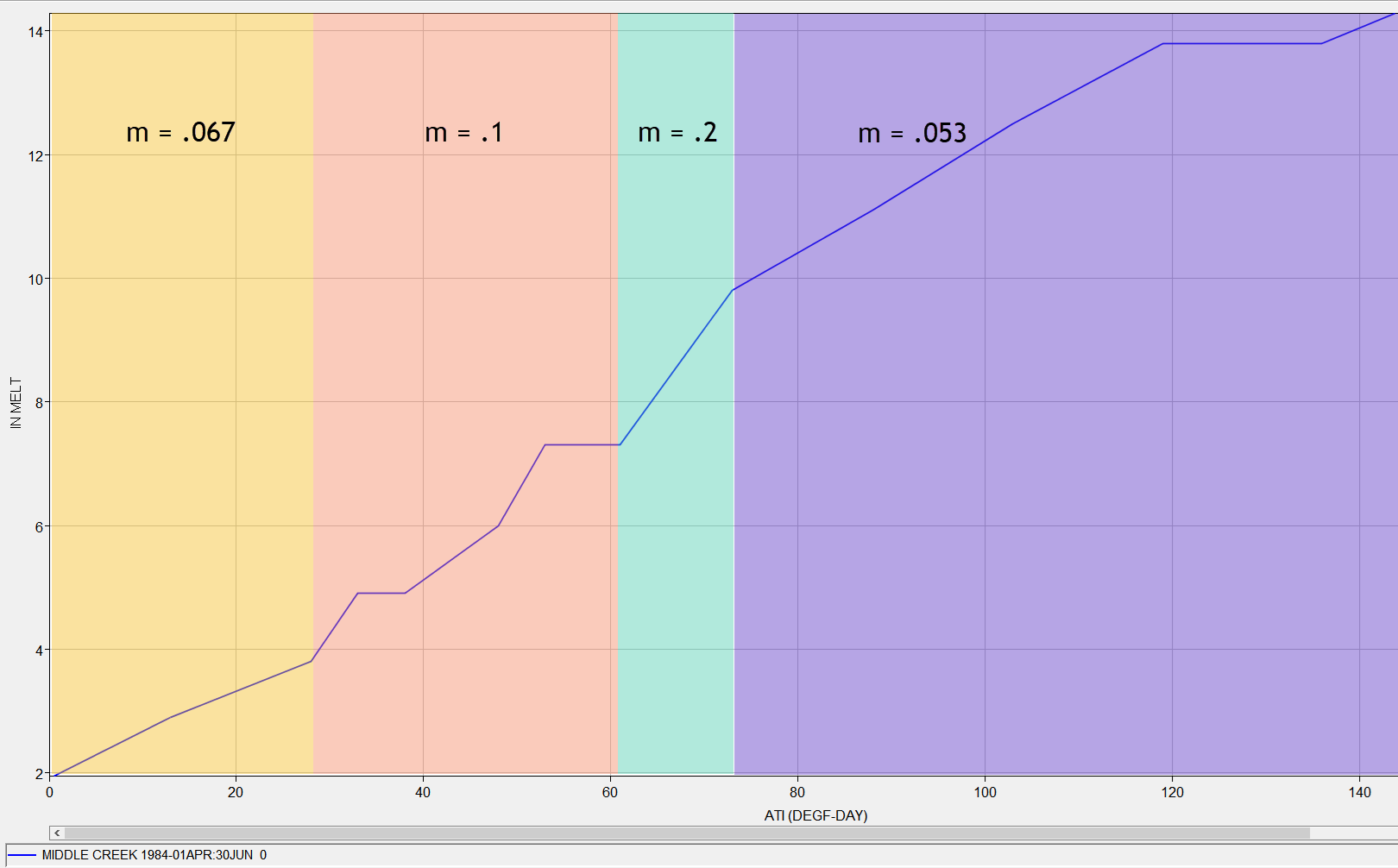
Using the slope found from the ATI vs. Cumulative Melt paired data relationship we can find the meltrate over multiple bands of ATI as represented by color bands over ATI values in the above figure. The ATI-Meltrate function table for this example would be the following:
ATI (Degree Days) | Meltrate (Inches / Degree Days) |
|---|---|
0 | 0.067 |
30 | 0.1 |
60 | 0.2 |
75 | 0.053 |
To build better ATI-Meltrate function tables for Snowmelt Modeling, it is recommended to use the ATI – Cumulative Melt relationship for all the gages in the watershed that have snowmelt, and to look at that relationship over many years of data. To calculate all the relationships manually would take a tremendous amount of work. To help users accomplish the task of creating better ATI-Meltrate functions for their snowmelt models, a script was created that can calculate ATI and Cumulative Melt for each water year for a location’s period of record data. The script is written in Jython and can be run from HEC-DSSVue. This script can make calculations for as many locations as are selected in DSSVue by the user, as long as the required data is available. The data required is: Precipitation, Temperature, and SWE. The script also builds the paired data relationship of ATI vs Cumulative Melt. The user can specify the date range to create the paired data relationship for, so that they can look at specific melt events within a water year. An example output of the script is shown in Figure 5 for ATI and Cumulative Melt.
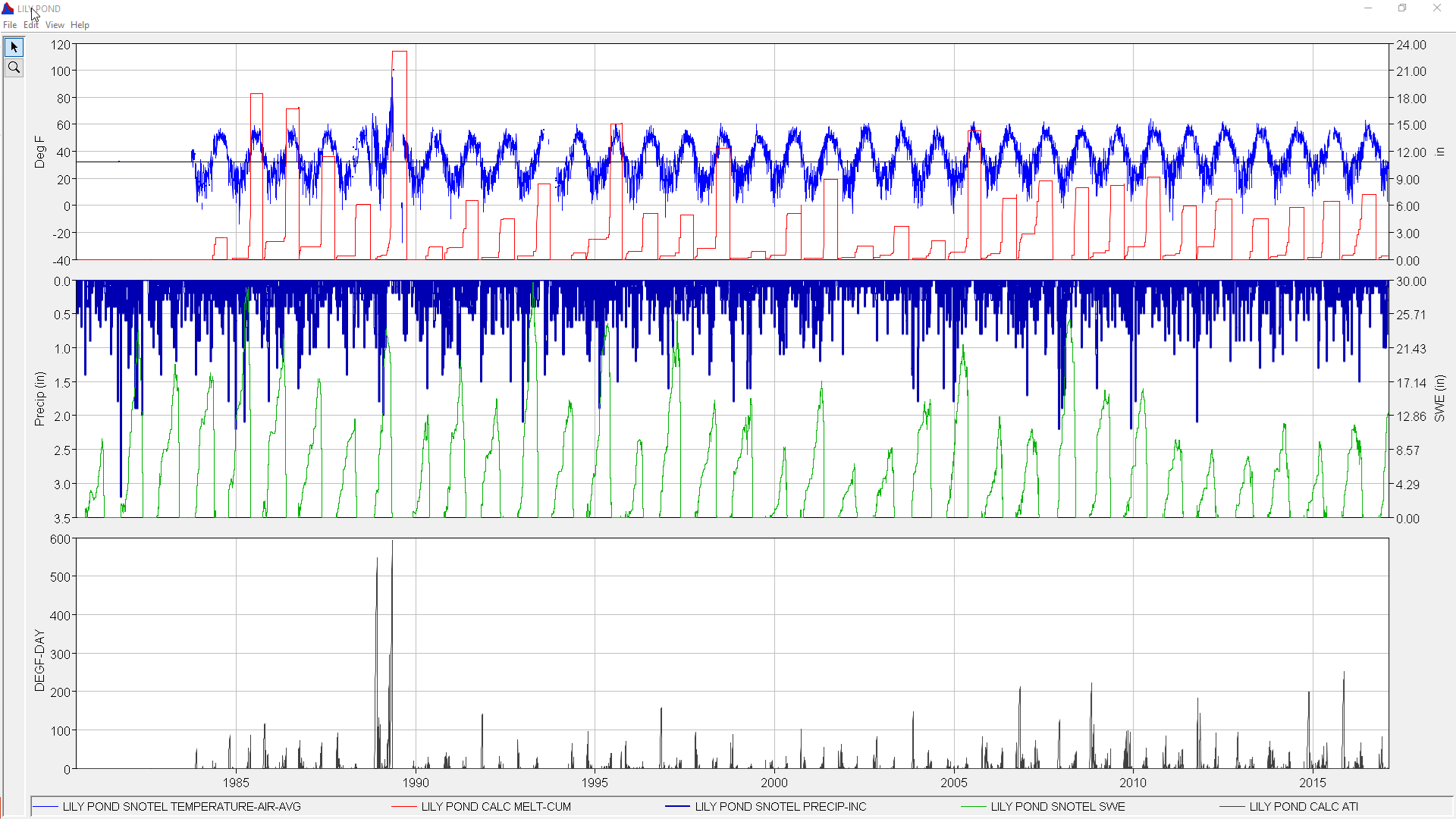
This output allows the user to see over the period of record where significant snowmelt events have occurred. They can then look at the paired data relationships for multiple water years or events and decide what ATI bands and Meltrates to use in their HEC-HMS model. We believe this tool provides users a great way to create Meltrate function tables for their models without having to simply use recommended values, which then must be adjusted through calibration. This method should give better initial results, which will translate into better and more easily calibrated models; thus, a more accurate snowmelt model for real-time forecasting using HEC-HMS in CWMS or HEC-RTS.
Additional features being developed for the script include the use of displaying and interacting with multiple water years’ worth of paired data such that the user can select which curves to automatically calculate slopes for from user specified ranges of ATI. This will better automate the workflow of building the table and give better visualization of the datasets. Figure 6 illustrates the intended enhancement.
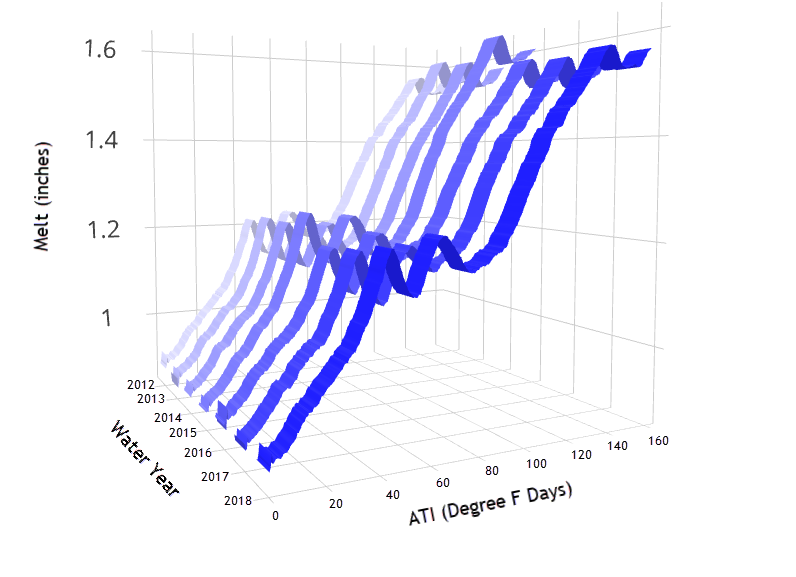
As work continues in developing the script to better visually assist users in choosing ATI bands for their Meltrate function tables, users will be encouraged to use the script to automate their data processing, which is already functional and available within workshops given for Snowmelt Modeling by HEC. To obtain workshop materials or to get more information on the Meltrate script please contact: Fauwaz Hanbali of HEC.